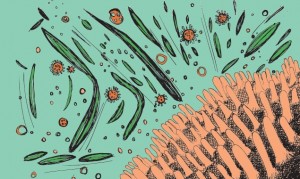Scientists from Virginia Tech University have found that antibiotic resistance is being passed from humans to wildlife, even in protected areas. The study, published by EcoHealth, investigated how E.coli is exchanged between humans and the Banded Mongoose in Botswanna. E.coli is commonly found in the gut of both humans and animals, and antibiotic resistance was seen as a good indicator of human-to-animal transfer of microbes.
Samples of faeces were collected from three three troops of banded mongoose living in Chobe National Park and three troops living in villages outside the park. Human fecal samples were also collected from sewage treatment facilities, environmental spills, and open-air latrines in areas where mongooses were known to live or visit. One of the authors of the paper, Kathleen Alexander, explained. “Banded mongoose forage in garbage resources and search for insects in fecal waste, including human sources found in the environment”, said Alexander. “Mongoose contact with other wildlife and humans, and broad occurrence across the landscape, makes this species an ideal candidate for evaluating microbial exchange and the potential for pathogens to be transmitted and emerge at the human-wildlife interface.”
Nine antibiotics which are widely distributed locally were screened for. These included ampicillin, tetracycline, doxycycline, and streptomycin, as well as a veterinary drug called ceftiofur, which is not widely available in the locality studied. The study found that 57 percent of banded mongoose had E. coli that was antibiotic resistant. The animals were most commonly resistant to ampicillin, followed by doxycyline, tetracycline, and streptomycin, with a significant amount of cases of multidrug resistant E.coli.
The researchers concluded that this exchange of microbes could extend through foodwebs, even leading to increased human exposure. This has led to several suggestions to minimize the impact of the exchange being put forward, including wildlife-proofing rubbish tips and preventing feeding animal products from kitchen waste to either wildlife or domestic animals.
According to Alexander, “Our next step is to begin to unravel the interdependent natural and human drivers of microorganism exchange, emergence of disease, and spread of antibiotic resistance among wildlife and across environments.”
The original paper can be read here : http://link.springer.com/article/10.1007/s10393-013-0838-2
![New study suggests drug resistant bacteria being passed on to wildlife Scientists from Virginia Tech University have found that antibiotic resistance is being passed from humans to wildlife, even in protected areas. The study, published by […]](/wp-content/uploads/2013/02/bacteria2-e1361997571365-620x300.jpg)
